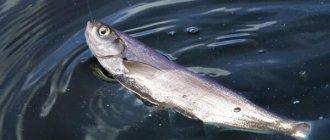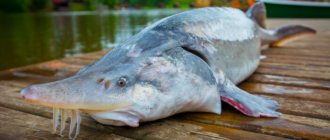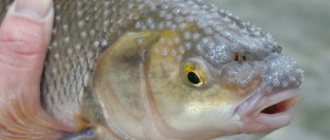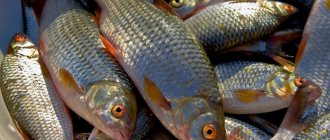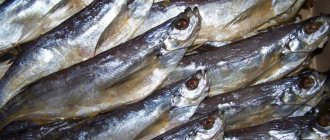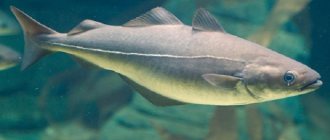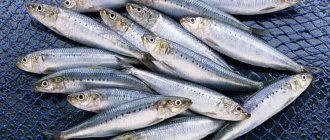Beluga fishermen deservedly call the king fish for its gigantic size.
. The Black and Caspian seas are the permanent habitat of the beluga; they are found in the Adriatic and Mediterranean seas. This fish is a long-liver, capable of living 100 years and laying eggs several times during its life. Beluga feeds on mollusks, crustaceans, and fish.
This is a predator. Ducklings and baby seals were found in the stomachs of fish
. Having reached sexual maturity, belugas go to freshwater rivers to spawn. It is believed that the spawning time of beluga occurs in May - June and lasts for a month. Eggs are deposited in deep-water rivers with fast currents and rocky bottoms. Not finding a suitable place, the beluga will not spawn eggs, which will eventually dissolve inside the fish. To occupy a place for spring spawning, female belugas remain overwintering in rivers, hibernating and becoming overgrown with mucus. One female can carry up to 320 kg of caviar.
The eggs are pea-sized and dark gray in color. Beluga caviar is eaten by other fish and carried away by the current. Out of 100,000 eggs, 1 survives
. The juveniles, having spent a month at the spawning site, slide into the sea. Beluga caviar has great nutritional value. This was the reason that fish were caught in huge quantities, which led to a decrease in their numbers.
The sale of beluga caviar is currently prohibited by law.
. After spawning, hungry belugas are busy searching for food. Old females even swallow inedible objects: driftwood, stones. They differ from young individuals by their large heads and emaciated bodies. Our ancestors did not eat such fish as food.
To catch a beluga, fishermen go out to sea, sailing 3 km from the shore
.
Using a pole, you need to find a place where there is a lot of shell rock at the bottom, which indicates the beluga’s feeding area. The bait is roach, asp, and herring. When dragging caught fish into the boat, you need to be careful, because there have been cases when a huge fish overturned the boat and the fisherman ended up in the water. Beluga is listed in the Red Book and is an object of sport fishing. The caught trophy must be released. At the beginning of the 20th century, beluga was a common game fish.
Tons of this fish were caught in the Danube, Dnieper, and Volga. After the loss of natural spawning grounds, the number of beluga sturgeon decreased significantly. No adults found, 98% are juveniles
. A hybrid of beluga and sterlet, bester, is artificially grown.
There are stories that belugas weighing 1.5 tons and 2 tons were caught, but these facts have not been confirmed. In 1922, in the Caspian Sea there was the largest beluga in the world, weighing 1224 kg
. A stuffed beluga 4.17 m long, caught in the early 20th century in the lower reaches of the Volga, is on display in the Kazan museum. When caught, the fish weighed 1000 kg. The Astrakhan museum houses a stuffed beluga caught in the Volga delta and weighing 966 kg.
All this allows us to call the beluga the largest freshwater fish. There are many facts known about the capture of belugas weighing 500, 800 kg
. All of them date back to the late 19th and early 20th centuries. Nowadays, the average weight of this fish is from 60 to 250 kg.
Hydroelectric power plants, sewage treatment plants, dams - all of these interfere with the reproduction, growth and survival of fish.
We present to you a video of a large beluga caught in Atyrau.
The sturgeon family is considered a valuable commercial species, the meat and caviar of which are distinguished by excellent taste. Representatives of the order have ancient origins; there is evidence of their existence in the Cretaceous period - more than 75 million years ago. Recently, as a result of negative factors associated with human activities, their numbers have been significantly reduced. Therefore, large commercial fish of the sturgeon family are listed in the International Red Book.
General characteristics of the sturgeon family
Sturgeon fish live in the water basins of the northern hemisphere - in Europe, North America and Northern Asia. The order is divided into anadromous and freshwater species. Representatives of an anadromous species migrate for spawning from salty seas to rivers. Spawning occurs in the spring-summer period; some species enter the rivers in the fall to overwinter.
Fish of the sturgeon family are considered to be the largest inhabitants of aquatic fauna; for example, beluga can reach a length of 4 m and weigh more than a ton. Sturgeon are distinguished by their long life expectancy: beluga can live about 100 years, sturgeon - about 50, stellate sturgeon - 30, and sterlet - 20 years. Puberty
Zooplankton - food for young sturgeon fish
individuals also occurs quite late: in females this age occurs no earlier than 10-15 years, in males - at 10-12 years. Only sterlet and shovelnose reach sexual maturity earlier. Moreover, the same individual does not go out to spawn every year, and reproduces only a few times during its life cycle.
The sturgeon diet consists of animal food: shellfish, worms, insects, and other fish. They prefer to stay and hunt at the bottom of reservoirs. The migratory species of sturgeon going to spawn practically does not feed during this period. Females are distinguished by high fertility - a large adult individual can lay several million eggs.
The most common species of the sturgeon family include:
- Sturgeon – Atlantic, Pacific, Russian, Persian, Amur, Siberian;
- Beluga;
- Kaluga;
- Shovelnose;
- Sevruga;
In addition to the main species, there are various hybrids that are the result of crossing in spawning areas. All sturgeon are similar in appearance; their body resembles an elongated spindle. The head is covered with small bony scutes, the muzzle is elongated in the shape of a spade or cone. The mouth with fleshy lips can extend, there are 4 antennae under it, and there are no teeth. Sturgeons do not have vertebrae; the skeleton is based only on a cartilaginous chord, which is preserved throughout life.
Sturgeon breeding
Dear visitors, save this article on social networks. We publish very useful articles that will help you in your business. Share! Click!
Sturgeon - a brief overview of the family members
There are 17 species of sturgeon, some of the fish in this family are on the verge of extinction. Sturgeon is a valuable commercial fish, the average weight ranges from 10-20 kg. The largest fish, according to archaeologists, weighed 2 centners and reached a length of 3 meters. Today there are individuals weighing about 100 kg, they can be found in the Black Sea basin. Sturgeon is classified as a bottom fish and can live at depths from 2 to 100 meters. Inhabits lakes, rivers, seas.
Among the largest anadromous species are the Atlantic sturgeon, which can be found in the Black Sea. This valuable game fish reaches 3 meters in length and can weigh over 200 kg. Unfortunately, today its population is significantly reduced, so artificial cultivation is practiced. The fish is characterized by high growth rates and high fertility of females. They go to rivers to spawn, after which they immediately slide into the sea, feeding mainly on anchovy.
In terms of numbers, Russian sturgeons are in first place, which are caught in the Black and Azov Seas, as well as in the Caspian Sea. The caviar of this fish is second only to beluga in value. It is actively mined in the Kura, on the Volga, and in the Danube. The diet of Russian sturgeons includes shellfish, shrimp and crabs. To spawn from the Caspian Sea they go to the Volga and Danube, from the Black Sea to the Dnieper and Danube, from the Azov Sea to the Don. Sturgeon fry can remain in the river for 1-2 years, although the main part goes to sea.
The non-anadromous species include the Siberian sturgeon. It does not need salt water to survive, which is something that fish breeders in captivity have begun to actively use. The sturgeon inhabits Siberian waters and travels many kilometers along the river mouth to spawn. Siberian sturgeon is divided into 4 subspecies:
- West Siberian - found in the Ob and Irtysh;
- East Siberian - inhabits the rivers of Siberia from the Yenisei to Khatanga;
- Yakut - lives in the rivers of Yakutia from Khatanga to Kolyma;
- Baikalsky;
Social structure and reproduction
Beluga fry
Having emerged from hibernation, the fish goes to spawn. Despite the fact that the female is capable of reproducing offspring at the age of 18, she begins to do this only when she reaches the required weight. And this happens only at the age of 25.
Interesting: What fish sleep underground?
At the same time, the female’s belly can contain up to 200 kg of eggs, and their number can reach several million. After meeting the male, she lays eggs in places with fast currents and sufficient oxygen.
Not all eggs have time to mature: most become a delicacy for other fish and local creatures. After hatching, the fry try to stay at shallow depths for the first time and feed on plankton. Their size ranges from 5 to 7 cm. The young grow quickly and gain weight. By the age of one year they can grow up to a meter in length and gain a couple of tens of kilograms.
A female can go to spawn 7-9 times in her life, doing this every 2-4 years.
Beluga and kaluga are the largest representatives of the sturgeon family
Beluga is the largest fish in the sturgeon family; it can grow up to 5 m in length and weigh more than a ton. Life expectancy is also the longest - 100 years. There are known cases of catching fish that were 70 years old, their weight was more than 1 ton, and their length was 4-5 meters. Lives in the Caspian, Black and Azov seas, very rarely found in the Adriatic.
Beluga is an anadromous fish, and the most prolific of all - the female spawns over 7 million eggs. The commercial weight of fish today depends on the place of catch: in the Volga basin it is 70 kg for males and 125 kg for females. In the Urals, the average harvest weight of beluga is slightly less - 40-60 kg for males, 60-100 kg for females.
Beluga meat is a little tougher than other sturgeon. Excellent for balyk products, the caviar of this fish is of excellent quality and is the size of a pea. The number of beluga has now fallen sharply as a result of predatory fishing by poachers. Its population is maintained in fish hatcheries. In nature, it interbreeds with other sturgeons, forming hybrids.
Kaluga is the largest representative of sturgeon living in fresh water. Lives in the waters of the Amur. It is very voracious, so it grows quickly. In the first 10 years of life, each year it grows by 10 cm and gains 10 kg in weight. It can live 80 years, reaching a mass of 1000 kg and 6 m in length. There are two types of beluga:
- Limannaya - goes to spawn in the estuary (shallow bay where the river flows into the sea);
- Sedentary - always remains in the riverbed, lives separately in small groups;
It begins to spawn in late spring; females reach sexual maturity no earlier than 16 years. After spawning, the individual loses a third of its weight; the next time spawning will occur again only after 5 years. Kaluga is a predator; young fry quickly switch to feeding on small fish. Adult fish prefer larger prey, literally sucking it in along with the water. Kaluga is considered an endangered sturgeon species, which is why it is listed in the International Red Book.
Record-breaking belugas
The maximum weight of the beluga is another question that has not been fully clarified by ichthyologists. There are records of specimens weighing up to two tons. However, unfortunately, there is no documentary evidence of these facts . So, the record holders:
- 1827, lower reaches of the Volga River. A press report about the capture of a fish nine meters long and weighing ninety pounds (1,500 kilograms).
- 05/11/1922, Caspian Sea. The catch of a female specimen weighing 1,224 kilograms, including 146.5 kg of caviar.
- The Kazan National Museum of the Republic of Tatarstan has in its exhibition a stuffed 1,000-kilogram beluga with a length of 4,170 millimeters. Presumably the seventy-year-old fish was caught at the beginning of the last century in the lower reaches of the Volga.
- A similar stuffed animal (4,200 mm and 966 kg) is kept in the Astrakhan Museum. The fact of its capture is interesting, since poachers caught this fish and, after removing the eggs, reported their catch to the authorities.
The analysis shows that the overwhelming majority of evidence of the catching of giant beluga specimens occurs at the beginning of the past - the end of the century before last. Significant changes in the ecological situation that characterize the present time have led to the fact that fish of this species rarely reach gigantic sizes. The weight of the largest specimens caught over the past few years does not exceed a quarter of a ton.
Sterlet is a small representative of the sturgeon order
The sterlet differs from its relatives not only in its smaller size, but also in its elongated narrow nose. The geography of its habitat is extensive: rivers in the basins of the Azov, Caspian and Black Seas, the Northern Dvina, Yenisei, Ob, Irtysh rivers. It was able to get into lakes Ladoga and Onega, was released and took root in the Western Dvina, Neman, Onega, Pechora, Amur, Oka and in a number of reservoirs.
The average length of commercial sterlet is 40-60 cm, weight is in the range of 0.5-2 kg. Sterlet differs from its relatives by earlier puberty; females begin to spawn at the age of 7-8 years. This fact makes it an attractive object for breeding in fish farms.
The sturgeon family is the most valuable commercial fish species, which in ancient times was served at the royal table. But poor ecology and poaching are leading to a rapid decline in its numbers. Therefore, today it is widely practiced to breed fish in special reserves for further release into the natural environment.
And a little about secrets...
Have you ever experienced unbearable joint pain? And you know firsthand what it is:
- inability to move easily and comfortably;
- discomfort when going up and down stairs;
- unpleasant crunching, clicking not of your own accord;
- pain during or after exercise;
- inflammation in the joints and swelling;
- causeless and sometimes unbearable aching pain in the joints...
Now answer the question: are you satisfied with this? Can such pain be tolerated? How much money have you already wasted on ineffective treatment? That's right - it's time to end this! Do you agree? That is why we decided to publish an exclusive interview with Professor Dikul, in which he revealed the secrets of getting rid of joint pain, arthritis and arthrosis.
What are the benefits of beluga?
Beluga contains a large amount of easily digestible proteins, saturates the body with fatty acids and improves overall well-being. When consumed in moderation, fish:
- stimulates the functioning of the cardiovascular system and prevents the development of strokes and heart attacks;
- accelerates metabolic processes and improves digestion;
- strengthens joints and protects against the development of osteoporosis and arthritis;
- improves the condition of gastritis;
- promotes muscle growth due to its high protein content;
- prevents the development of atherosclerosis;
- increases physical endurance;
- stimulates brain activity and improves memory.
We recommend reading: The benefits and harms of greenling fish for the human body
You can eat beluga meat in small quantities on a diet. Fish does not promote weight gain, but it does help maintain healthy muscle mass.
Regular consumption of beluga protects against the development of cancer processes
Video: Sturgeon War
It can be considered the largest freshwater fish on the globe. If information from unverified sources is correct, then beluga sturgeon in the past, as an exception, reached even nine meters. In this case, it takes second place among the largest fish from fresh water.
The maximum measured beluga specimens caught in different years do not reach five meters:
- 4.24 meters is the length of a female caught in the Caspian Sea near the mouth of the Ural River (1926). It was a 75-year-old fish that weighed more than one ton.
- 4.17 meters - the length of the beluga from the lower reaches of the Volga (early 20th century). The age of this specimen was estimated at sixty to seventy years.
- 4.20 meters – the length of a specimen caught in the Volga River delta (1989). Now a stuffed beluga can be seen in the museum of the city of Astrakhan. There is no information about age.
If we rely on reliable data on measurements of the length of the largest individuals, then the beluga fish still yields first place to the kaluga, the largest measured specimen of which exceeded five meters and was equal to five meters and sixty centimeters.
If we analyze the weight of beluga fish caught in different years and documented, we can assume that the largest individual of this species still greatly exceeded five meters. Published in 1861, “Research on the State of Fisheries in Russia” reported on a huge beluga caught in 1827 in the lower reaches of the Volga, weighing one and a half tons (1,500 kilograms). If these figures are compared with the weight of an individual 4 meters 24 centimeters long, which was more than one ton (1000 kilograms), then the reality of the existence of a beluga measuring more than five meters becomes obvious. After all, the 1,500-kilogram fish caught in 1827 was probably about 6 meters long or more.
Thus, the maximum measured weight of the beluga fish (1500 kg) is the criterion for recognizing it as the largest freshwater fish. And Kaluga takes second place, since its maximum weight is estimated at one ton (1000 kilograms).
Appearance Features
The description of the beluga fish is very reminiscent of its relative kaluga:
- The long body looks like a huge spindle of gray color, lighter in the abdominal part.
- The caudal fin is unequally lobed with the upper lobe almost twice the size of the lower one.
Below is a photo of a beluga fish, in which all the descriptions of the features of its appearance are clearly visible.
The beluga has a pointed but short snout, under which there is a huge crescent-shaped mouth that extends over the head and two pairs of whiskers with clearly visible leaf-like appendages along the entire length of each antennae. In the photo of the beluga fish, you can clearly see both the mouth and the leaf-like appendages on the whiskers.
How can one distinguish between these two huge fish from the sturgeon family of the order Sturgeon and those belonging to the same genus Huso? After all, the general description of beluga fish is almost the same as for kaluga, but there are clearly visible differences. Kaluga (Huso dauricus) differs from beluga sturgeon (Huso huso) in the structure of its antennae, located under the elongated snout. Watch a video of how Moskvarium guides show these differences during the tour.
Lifestyle and distribution
Beluga sturgeon is migratory, as are salmon. As an adult, it lives in seas with different salinities:
- In the Caspian and Azov seas (salinity from twelve to thirteen ppm).
- In the Black Sea, the salinity of which is from seventeen to eighteen ppm.
- In the Mediterranean Sea, with high salinity, like in the ocean - about thirty-five ppm.
Belugas enter rivers to breed:
- From the Caspian Sea they go to the Volga, Kura, Ural and Terek to spawn. In past years, beluga whales ascended to spawning grounds located quite high in the Volga River basin. They even reached Tver, entered the Kama River and moved to its upper reaches. Currently, this is no longer observed.
- From the Sea of Azov, beluga goes to the Don to spawn, and in very small numbers to the Kuban. In the past, along the Don, spawning adults rose very high, now - no higher than the Tsimlyansk hydroelectric station.
- From the Black Sea, the largest number of sexually mature individuals are sent for spawning to the Dniester, Danube and Dnieper, since it is the northwestern part of the Black Sea waters that is the main habitat of beluga in this sea. In past years, as in the spawning rivers of other seas, during reproduction, fish were observed moving very high in the basin of each of the listed rivers. For example, along the Dnieper, rare specimens were noted even near Kiev.
Reproduction and hybridization
Beluga is a long-liver, living up to the age of one hundred years. If Pacific salmon are able to spawn only once in their life and die immediately, then beluga spawns many times during their life. Having finished spawning, adult individuals return to the sea and continue to feed until the next spawning. Fish with this lifestyle that migrate to rivers to reproduce are called anadromous.
Beluga caviar is dark gray with a silver tint, quite large (up to 2.5 millimeters in diameter) and sticky. It is deposited on the bottom, where it adheres to various substrates. The fry that emerge from the eggs are also rather large – from fifteen to twenty-four millimeters. Almost immediately after hatching, they roll into the sea. It happens that individual specimens can remain in rivers for several years (from five to six).
Under natural conditions, there are hybrids of beluga with other species of sturgeon, for example, with sterlet, sturgeon, thorn and others. The result of artificial breeding is a hybrid called bester: the result of crossing a beluga with a sterlet. Bester is quite resilient and is successfully grown in both reservoirs and pond farms. He was settled in the Sea of Azov, where he feels good.
Timing of puberty and fertility
Beluga males become sexually mature earlier (at the age of thirteen to eighteen years). Females begin spawning at the age of sixteen, and some at twenty-seven, but most of them first participate in spawning at the age of 22. The beluga sturgeon living in the Sea of Azov matures earlier than other populations: males can spawn as early as twelve years of age.
In Huso huso (beluga), fertility varies among females of different sizes: from half a million eggs to one million. It's rare to have five million. In different rivers, females of the same size can have markedly different fecundity. For example, there is evidence that in the Volga large individuals (about two and a half meters long) spawn approximately a little more than 900 thousand eggs. In the Kura River, females of the same size lay slightly less than 700 thousand eggs.
Migrations and nutrition
When migrating to rivers to spawn, most beluga populations spawn in the same year. These are spring fish. But there are a number of fish that winter in the river and spawn the following year. They spend the winter in holes located at the bottom of the river, spawn in the spring, and then return to the sea.
Belugas are predators; the main diet consists of fish. The hatched fry immediately begin to predatory. While feeding in the sea, belugas eat mainly fish, such as herring, gobies, sprat), and can also eat shellfish. Sometimes baby seals (pups) of seals were found in the stomachs of beluga sturgeons from the Caspian Sea. Belugas going to spawn in the waters of the Volga usually do not feed.
Man and beluga
Beluga has always been and is now a very valuable commercial species. Not only caviar and meat are used for food, but even the chord from which viziga is made. And swim bladders are dried to prepare a special glue, which is used in winemaking to clarify wine.
In the Sea of Azov, there is currently a decline in the number of beluga sturgeon.
There are several reasons:
- Destruction of natural spawning grounds in rivers, which occurred as a result of the construction of hydroelectric power stations.
- Small natural spawning population.
- Shortage of producers for effective artificial reproduction.
- Too much fishing for a long time.
In the Sea of Azov, since 1986, there has been a ban on beluga fishing. In the International Red Book, the beluga has a protected status as a species on the verge of extinction.
Beluga (lat. Huso huso) is a species of ray-finned fish of the order Sturgeon, family Sturgeon, genus Beluga.
Beluga is the oldest fish on the planet, appearing on earth over 200 million years ago. The only closest relative of the beluga is the kaluga, an inhabitant of the river basins of the Far Eastern region.
How to cook better
In cooking, fresh beluga is processed in all basic ways. Meat is frozen and canned, smoked and dried, baked in the oven and stewed, fried and boiled. In addition to fillets, the insides of fish are eaten - everything except the liver. They can only be eaten fresh; they are not suitable for freezing or canning.
Beluga caviar has a certain value. It contains many vitamins and microelements and has a pleasant taste. It is usually processed in a granular manner or mixed with stellate sturgeon caviar.
Several recipes using beluga are the most popular. They require simple ingredients and allow you to process fish fairly quickly.
Stewed beluga with vegetables
Stewed beluga with vegetables is a nutritious and healthy second course, retains maximum valuable properties and has a beneficial effect on digestion. According to the recipe you need:
- beluga fillet - 500 g;
- sweet pepper - 4 pcs.;
- tomatoes - 4 pcs.;
- onions - 1 pc.;
- butter - 10 g;
- salt - to taste;
- Dijon mustard - 3 tsp.
The step-by-step cooking algorithm is as follows:
- Sweet peppers are cut into halves, the seeds are removed, and then the pulp is chopped into small strips.
- Peel the tomatoes and divide each fruit into eight slices.
- The onion is chopped into half rings, and the fish is cut into slices 2 cm thick.
- The beluga is coated with mustard and left to marinate for several hours.
- After some time, heat the butter in a deep saucepan.
- Place fish in a container, salt to taste and add vegetables.
- Add a small amount of water and simmer, covered, over medium heat for 20 minutes.
Ready-made beluga fish with vegetables can be eaten as an independent dish. The product has an average calorie content; in small quantities it saturates well, but does not overload the digestive tract.
Attention! If desired, the stewed beluga fish can be sprinkled with black pepper and your favorite spices to enhance the taste.
It is recommended to serve stewed beluga with fresh herbs and lemon slices
Beluga in English
Beluga fish in English is cooked in the oven using vegetables and spices. The dish turns out to be nutritious and very flavorful, and can serve as a complete lunch. Ingredients needed:
- beluga meat - 1.7 kg;
- cucumbers - 100 g;
- capers - 100 g;
- ketchup - 2 tbsp. l.;
- mayonnaise - 300 g;
- butter - 2 tbsp. l.;
- lemon - 1 pc.;
- fish broth - 1 glass;
- breadcrumbs - 40 g;
- salt - to taste;
- pepper - to taste.
We recommend reading: Burbot: beneficial properties, what it looks like, contraindications
The preparation scheme is as follows:
- The fish is cleaned and washed, divided into portions, scalded with boiling water and dried on a paper towel.
- The fillet is salted and peppered to taste, rolled in breadcrumbs and placed in a ceramic pot greased with butter.
- Cucumbers and capers are finely chopped and mixed with mayonnaise, and then ketchup and fish broth are added.
- The sauce is placed on the fire and brought to a boil, and then poured over the beluga.
- The ceramic pot is covered with a lid and placed in an oven preheated to 180 °C.
Beluga fillet in English is cooked for half an hour. After this, the hot fish is placed on plates and decorated with lemon slices.
A good side dish for beluga fillet is boiled or baked potatoes.
What does a beluga look like?
Beluga is considered the largest of all freshwater fish. The body of an adult reaches a length of 4.2 m, and the weight is about 1.5 tons, with females being slightly larger than males.
The beluga's thick, cylindrical body is covered with five rows of bone formations - scutes, and noticeably tapers towards the tail. The bone plates covering the head, sides and belly are poorly developed. More durable shields, 13 in number, are located on the back and perform a protective function.
Like all ray-finned fish, the fins of the beluga are distinguished by the presence of long and sharp, jagged rays: the dorsal contains at least 60 rays, the anal from 20 to 40.
The elongated head ends in an upturned, pointed nose, which is slightly translucent due to the absence of bony scutes. The beluga's mouth is quite wide, but does not extend beyond the sides of the head; a fleshy upper lip hangs over it. The antennae, located on the sides of the lower jaw, are wider and also longer than those of most sturgeons and perform an olfactory function.
The beluga's back is greenish or ash-gray in color, its belly is white or light gray, and its nose is characteristically yellow.
Where does the beluga live?
Belugas are migratory fish, and spend most of their lives in the waters of the Black, Azov and Caspian Seas, and migrate to rivers only during the breeding season, and after spawning they go back to the sea.
By nature, belugas are solitary. Adults and mature individuals live at great depths; juveniles prefer shallow water, not far from the mouth of the river.
In summer, after spawning, the fish rests at medium depths and then fattens before hibernation. Before the onset of cold weather, the body of the beluga is covered with a “fur coat” of a thick layer of mucus, and the fish falls into a state of suspended animation until spring.
What does beluga eat?
Large fish need a lot of food, and the size of individual individuals directly depends on the diet: the better the fish eats, the larger the size it reaches. The main food of the beluga is various types of fish, and the beluga begins to prey at a very young age, as a fry.
Adults successfully hunt both on the seabed and in the water column. The favorite foods of beluga are gobies, herring, sprat, sprat, anchovies, roach, anchovy, as well as representatives of the numerous carp family. A certain part of the diet consists of crustaceans and mollusks, and even small animals, for example, baby Caspian seals or waterfowl.
Beluga jumps out of the water.
Beluga breeding
Belugas are long-lived animals, some specimens live up to 100 years, so they reach reproductive age late. Males are ready to breed at the age of 13-18 years, females mature at 16-27 years. Spawning occurs at different times of the year and depending on this, beluga of the spring and autumn runs are distinguished.
Spring beluga enters rivers from late January until almost summer. The autumn beluga begins its migration at the end of summer and ends in December, so it is forced to winter at the bottom of the river in deep holes, and begins to reproduce only next spring.
Each sexually mature individual does not reproduce every year, but at a certain interval, usually 2-4 years. The spawning grounds of beluga pass along deep rocky ridges, amidst fast currents.
The fertility of a female depends on her size, but in any case, the amount of eggs spawned is 1/5 of her own body. The average amount of caviar is from 500 thousand to a million.
Dark gray eggs, 3 mm in diameter, look like peas. Thanks to its increased stickiness, caviar sticks perfectly to cold underwater rocks. At a water temperature of + 12-13 degrees, the incubation period is only 8 days.
Once born, the fry immediately switch to higher nutrition, bypassing the diet consisting of simple organisms. Without stopping, the juveniles go to the seas, where they live until the onset of puberty.
Beluga is the largest freshwater fish and is now under threat of extinction. Man illegally kills it for valuable caviar, changes the usual spawning routes, destroys and pollutes habitats. Like many other endangered species, the beluga is truly unique. Why this is so, and which beluga is the largest in the world - read about it in the article.
Description of the species
In the large sturgeon family, which includes 27 species, there are many giants. Partly for their size, as well as for the value and nutritional value of their meat and caviar, these fish have earned the status of commercial fish. Sturgeon inhabit the waters of the Northern Hemisphere. The evolution of these species dates back to the Triassic period and dates back 208-245 million years. Their heyday occurred 100-200 million years ago, when dinosaurs still inhabited the earth. Since then, their appearance has remained almost unchanged.
The beluga (lat. Huso huso) stands apart in their family. Not only is it the record holder for longevity—individuals over 100 years old are known—but also for its size. Beluga is deservedly considered the largest freshwater fish. The weight of the largest specimens caught reached one and a half tons! Body sizes on average range from 2 to 4 meters, although individuals up to 9 m in length have been described.
Beluga looks unusual. Looking at it, you can understand a lot about the times of dinosaurs. The fish’s body seems to be encased in a shell of bone, and along the sides there are paths of sharp bone protrusions. The beluga's mouth is framed with antennae, which are responsible for the sense of smell - it is excellent in these fish. But this predator has no teeth. The body color is dark gray, with a greenish tint, the belly is almost white.
Beluga grows throughout its life, and since it can live a long time, its size will be appropriate. Unfortunately, in our time, due to uncontrolled catching, habitat pollution, changes in habitual migration routes and general deterioration of the environmental situation, the life expectancy of the beluga has been greatly reduced.
Origin of the species
Close-up of a beluga's head
Beluga belongs to the chordate animals, a class of sturgeons. Scientists believe that this species appeared approximately 85 million years ago, during the Eocene. Along with it, sturgeon, sterlet, stellate sturgeon and other related fish also formed. Their common ancestors first appeared in the waters of the Earth 200 million years ago, when dinosaurs dominated the planet.
Since its appearance, the fish has practically not changed in appearance - bone plates are still formed on the body of modern individuals, which were equipped with most underwater creatures that lived millions of years ago.
Beluga is considered the largest fish living in fresh waters.
There are suggestions that its mass can reach two tons, but this has not yet been proven. Interesting fact : the largest beluga was caught in 1827, its weight was 1500 kg. The second largest individual was encountered by people in 1922 and weighed 1224 kg.
Nutrition
Beluga is a predator fish. It can feed on mollusks, worms, and insects, but its main “dish” is fish. Even beluga fry are predators. Large belugas can even swallow seal pups - they are sometimes found in the stomachs of Caspian representatives of the species. Feeling hungry after spawning, beluga females even grab inedible objects: driftwood, stones.
Such giant creatures can only find enough food in the sea; those subspecies that prefer to live in fresh water do not reach huge sizes.
Reproduction
Beluga emerges from the sea and rises high in rivers to spawn. They spawn only in fresh water, but can live in both fresh and salt water. Belugas spawn several times in their lives. After spawning, it rolls back into the sea.
Belugas take a long time to reach sexual maturity. Males mature in the second decade of life, and females generally only mature at 22-25 years.
Sturgeon fish are unusually prolific; depending on the size of the fish, the number of eggs can range from 500 thousand to a million. There is evidence that large, by today’s standards, 2.5-2.6 m long, Volga belugas lay an average of 937 thousand eggs, and the same size Kura beluga eggs - an average of 686 thousand. The fry live in the delta and on the seashore.
Belugas can only spawn in very clean water. If the reservoir is polluted, the females refuse to spawn, and the eggs that have matured in their body dissolve after some time. The presence of beluga in a reservoir indicates a favorable environment and good ecological conditions.
Most individuals are caught by poachers when they are still young, having just reached sexual maturity, which means they only have time to spawn once. The survival rate of eggs and fry is only 10% of the total number of eggs spawned, so the beluga population is very poorly replenished.
Normally, spawning occurs in one individual up to 10 times during its life, since due to its size and life expectancy, it needs from 2 to 4 years to recover between spawning periods.
Habitat and migration of fish
There is no specific habitat for the beluga, as it is considered anadromous .
Spawning occurs in fresh water reservoirs into which fish enter from the sea. The large individual finds food only in the sea (Black, Caspian and Azov). Until recently, the number of fish was enormous and their fishing did not stop. To collect priceless eggs, females were more often caught. In the Caspian Sea, beluga can be found almost everywhere, and for spawning it swims to the Volga, Ural, Terek and Kura. It also happened that from 1961 to 1989, fish swam even to Volgograd, and therefore a fish lift was built there, old photos of which can be viewed on the Internet.
In the Black Sea, beluga was seen near the Crimean coast in places where hydrogen sulfide is present. Quite large individuals were spotted near Zaporozhye and Dnepropetrovsk - their weight was approximately 300 kilograms.
